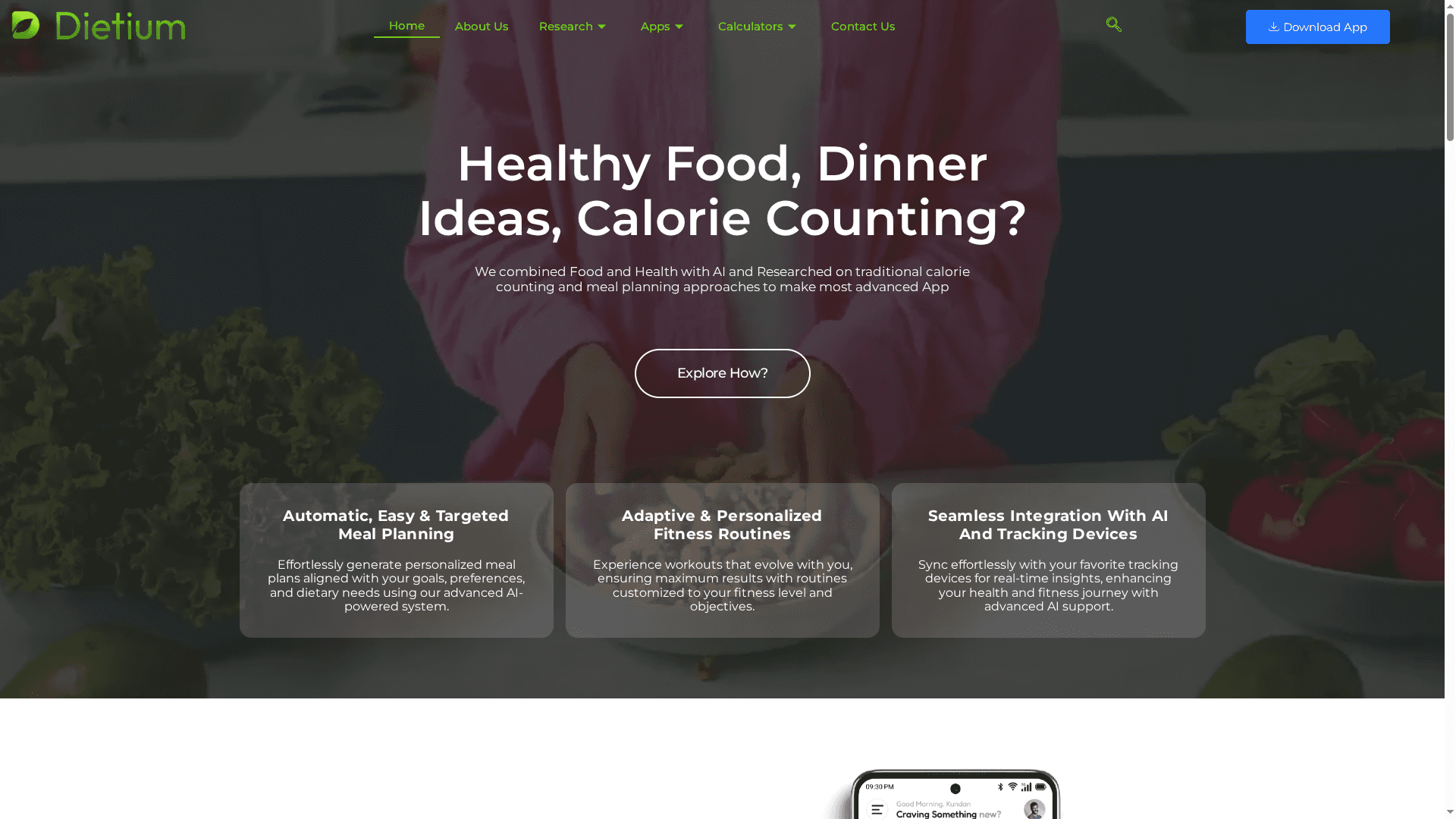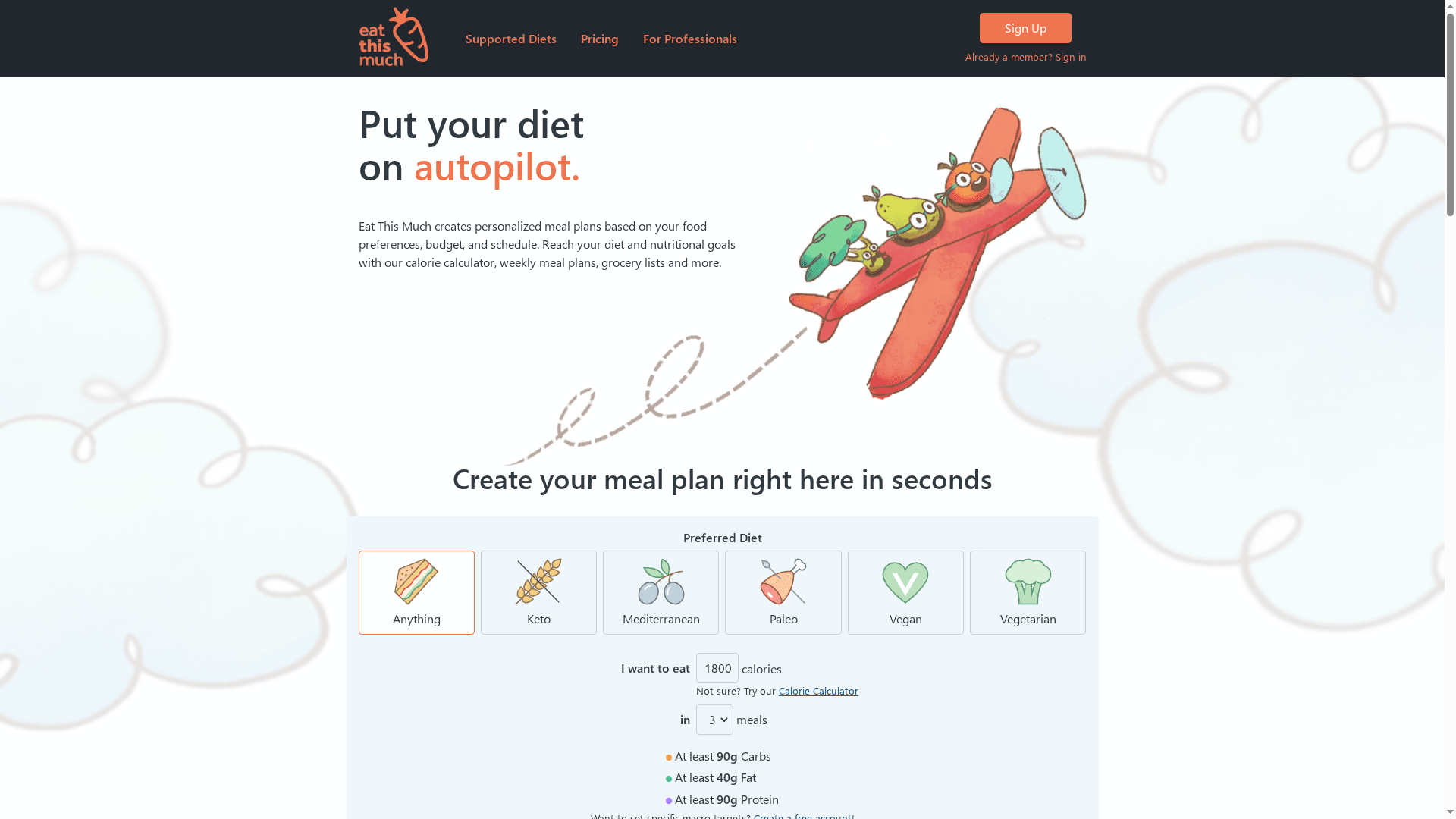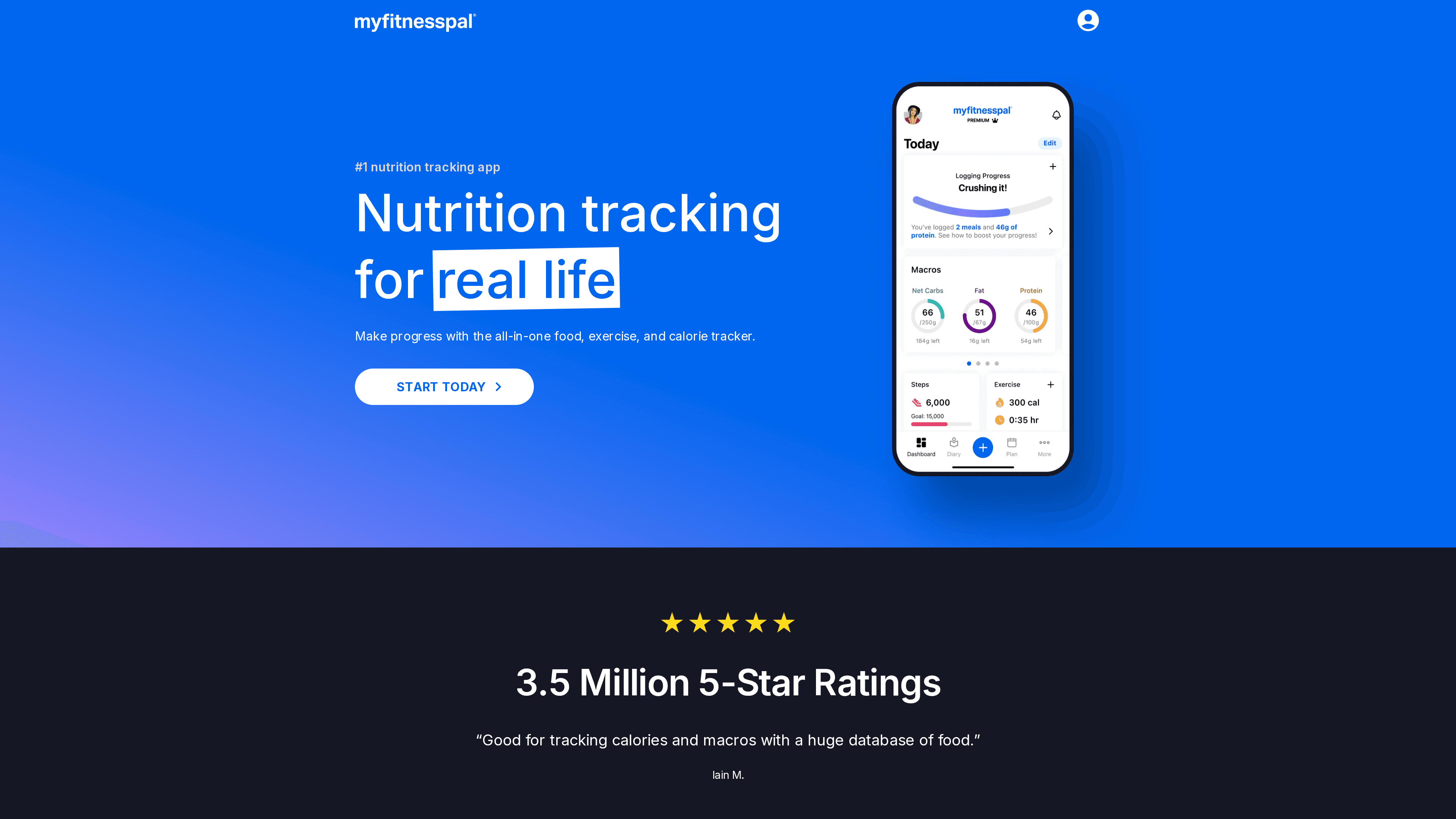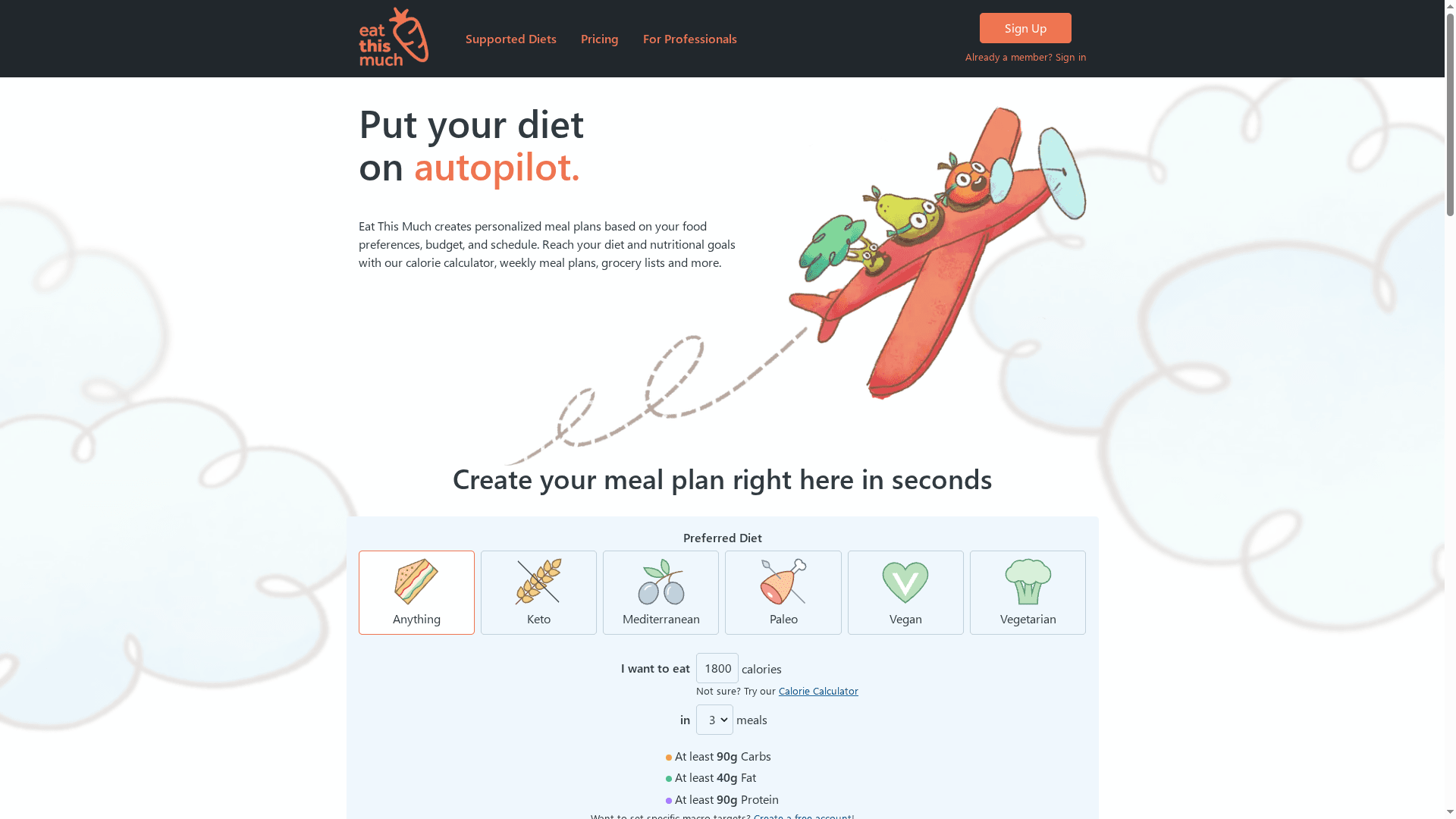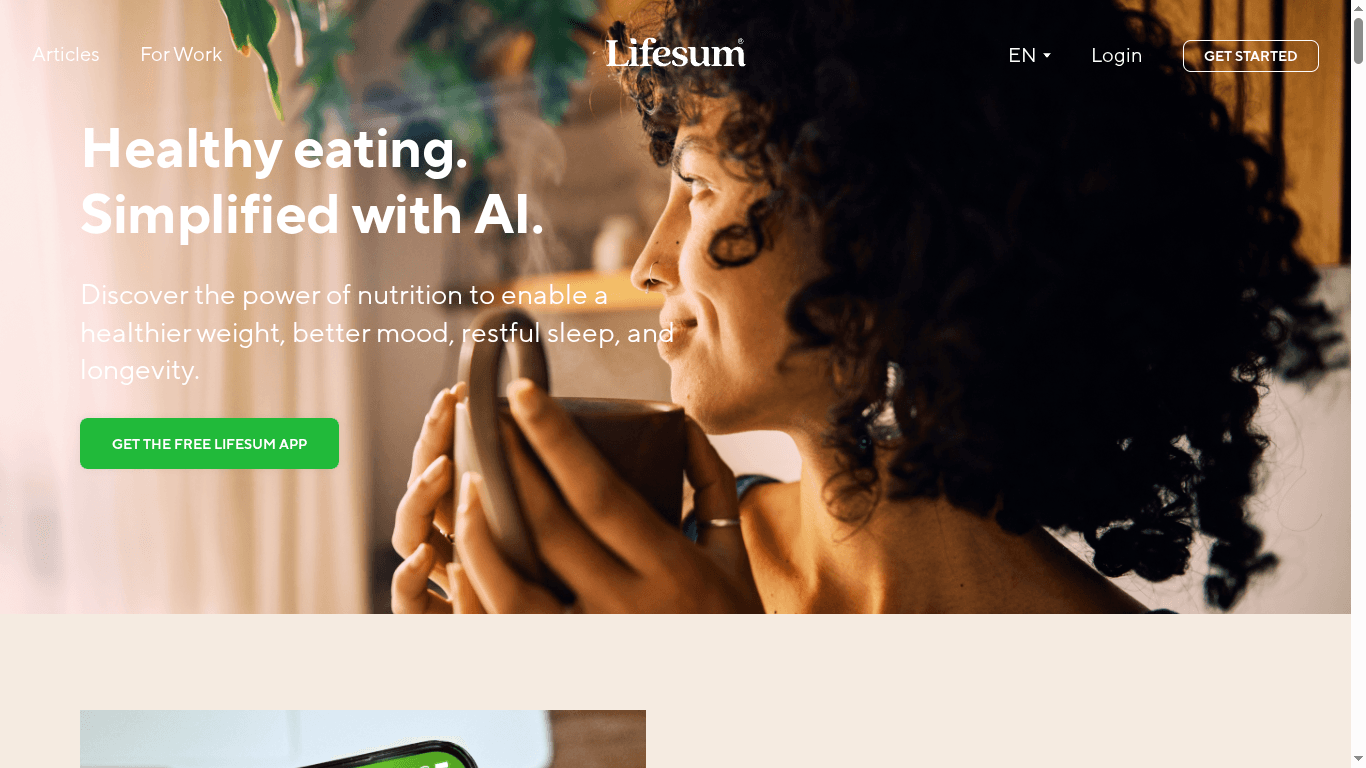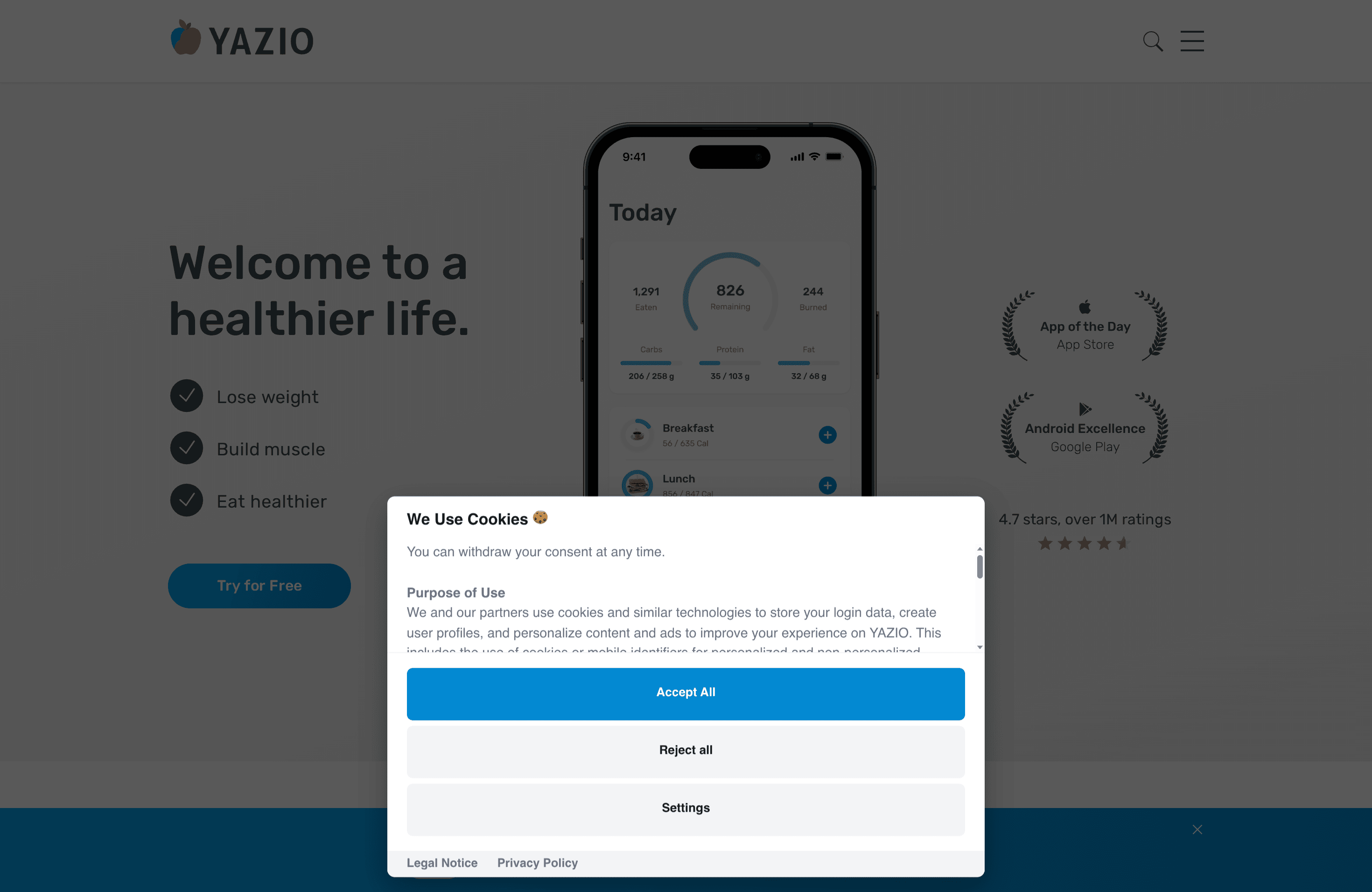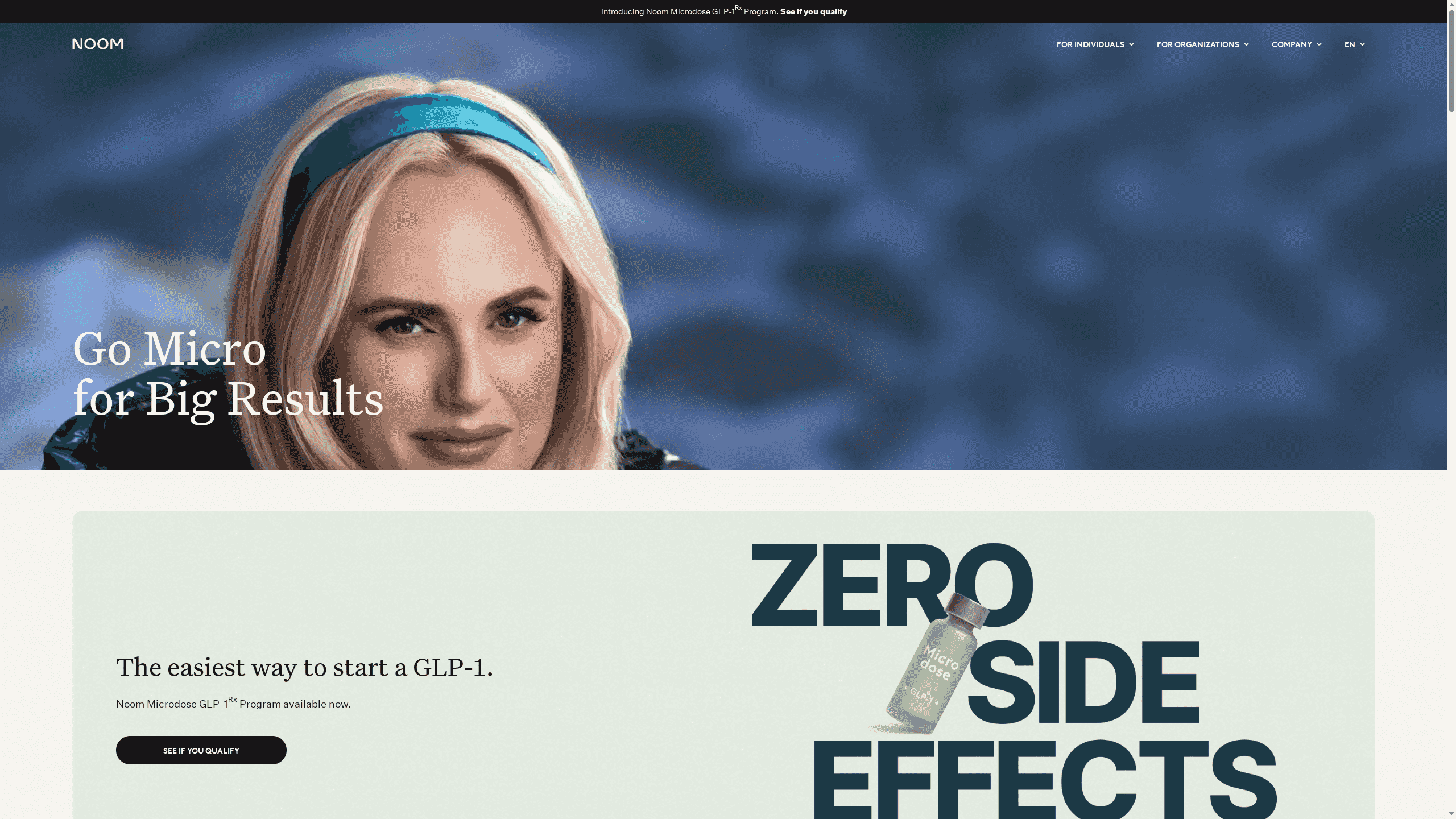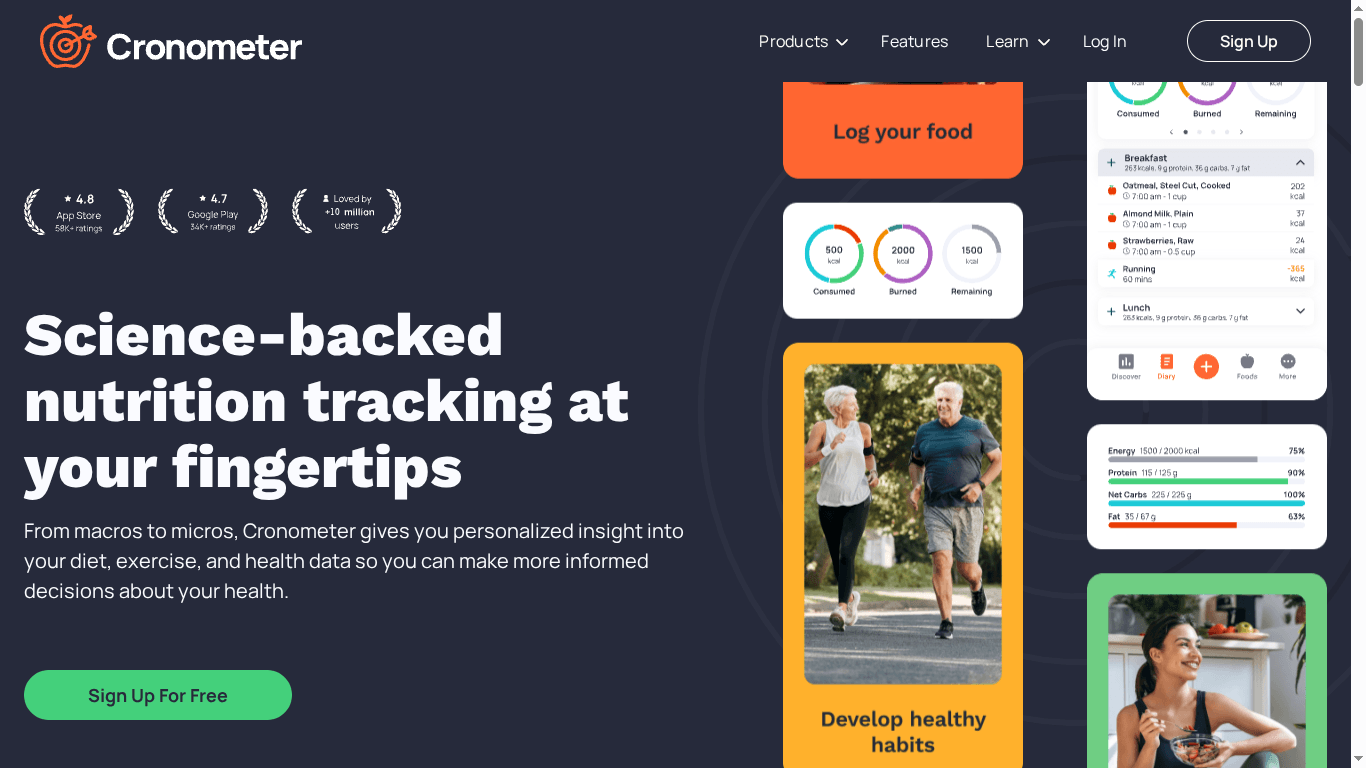Finding the right tool for healthy eating can feel confusing with so many options promising different paths to better meals and fitness. Some focus on easy tracking and guidance while others offer smart planning or even personal coaching and expert recipes. You might be curious which app helps you stay motivated or which one gives the best mix of recipes, habit-building, and real science. With so many features for tracking, planning, or support, there is something for anyone looking to take control of their diet or fitness goals. See how these different apps stack up and which approach could turn your daily routine into real progress.
Table of Contents
Dietium
At a Glance
Dietium is a data-driven health and wellness hub that pairs advanced AI with practical tools to make personalized meal planning and fitness tracking simple and sustainable. Its strength lies in seamless device integration, real-time coaching options, and a central app (Recipians) that delivers custom meal plans, recipe inspiration, and fitness routines aligned to your goals. The platform also bundles evidence-based educational content and health calculators so your decisions are grounded in measurable metrics. Pricing and precise platform availability aren’t specified publicly, a deliberate focus that suggests product refinement over marketing noise.
Core Features
Dietium centers on AI-powered personalized meal planning and adaptive fitness routines that evolve with your input and tracked progress. It integrates advanced food, health, and fitness calculators to help you monitor BMI, body fat, and calorie requirements, while giving nutritional tracking for calories, water, and sleep. The Recipians app provides custom recipes and meal plans, plus quick dinner ideas and daily recipe suggestions. Device integrations supply real-time activity and biometrics, and live video consultations with chefs add professional cooking guidance. Finally, Dietium’s content library—blogs, health tips, and scientific research updates—reinforces an evidence-based approach rather than trendy advice.
Pros
- Highly personalized recommendations that evolve with user preferences: Dietium’s AI adapts meal plans and workouts as your tastes, goals, and metrics change so you stay on track without manual reprogramming.
- Comprehensive health tracking including calories, water, and sleep: You get a holistic view of progress across nutrition, hydration, and recovery, not just steps or calories.
- Integration with multiple tracking devices for real-time insights: Connected devices feed live data into plans so recommendations reflect current activity and physiology.
- Access to professional cooking guidance via live video calls: Real-time chef consultations turn nutrition plans into practical kitchen skills and confidence.
- Educational content and health calculators: Built-in calculators for BMI, body fat, and calorie needs pair with research-backed articles to support informed choices.
Who It’s For
Dietium is ideal for health-conscious individuals, fitness enthusiasts, and tech-savvy users who want an integrated, data-first approach to diet and exercise. It’s especially useful for people managing weight, following specialty diets, or those who want to learn cooking techniques while tracking progress through connected devices. Busy professionals who need quick, healthy meal ideas and guided routines will find the Recipians workflow particularly time-saving.
Unique Value Proposition
Dietium’s unique value is consolidation: it combines AI meal planning, adaptive fitness routines, precise calculators (BMI, body fat, calorie needs), live chef coaching, and seamless device integration into one ecosystem. That breadth means fewer apps, less manual tracking, and recommendations that reflect real-time biology and behavior—something many single-focus competitors can’t match. Dietium emphasizes evidence-based content and interactive tools, so you don’t just follow a plan; you understand why it works. Potential limitations—unspecified pricing and platform rollout—are framed as product-stage choices that prioritize refining AI and integrations before broad marketing, ensuring the core experience is dependable and clinically informed. In short: if you want a single, science-minded platform that grows with you, Dietium is purpose-built for that journey.
Real World Use Case
A busy professional receives weekly Recipians meal plans tailored to dietary needs, logs sleep and water through connected devices, and tracks weight and body-fat trends via the platform’s calculators; when they want to cook a new healthy dish, they book a 20-minute live session with a chef to learn technique and timing—then the app adjusts future meals based on adherence and device-collected activity.
Pricing
Not specified — likely free tier available with premium subscription options.
Website: https://dietium.com
Eat This Much
At a Glance
Eat This Much is an automatic meal planner that builds personalized weekly plans, grocery lists, and calorie-aware recipes based on your preferences, budget, and schedule. It blends macro tracking, multiple diet styles (keto, vegan, paleo), and pantry-aware planning to reduce food waste and save time. The app suits anyone who wants data-driven meal structure without writing menus from scratch, though highly specific clinical diets may require extra tweaking. Bottom line: powerful automation for real-world meal planning with a modest learning curve.
Core Features
Eat This Much generates personalized meal plans and grocery lists automatically, using a calorie calculator and flexible macro targets to hit your goals. It supports multiple eating styles, recurring foods for habit-building, meal collections, and quick regeneration of meal ideas when you need variety. The platform also includes a food pantry feature to reuse ingredients, nutritional stats and progress tracking, and integrations for grocery delivery to streamline shopping and reduce friction.
Stop guessing. Eat with intent.
Pros
- Highly customizable meal plans tailored to individual needs: You can set calorie and macro targets, choose eating styles, and adapt plans to your schedule so the output closely matches your goals.
- Automatic and integrated grocery shopping and delivery: The app produces grocery lists and connects to delivery services, which shortens the loop from planning to eating.
- User-friendly interface and recipe management: Recipe collections, recurring foods, and quick regeneration of ideas make it straightforward to manage meals without starting over each week.
- Large community and strong social proof: High ratings and thousands of reviews indicate widespread user satisfaction and a mature product experience.
- Supports multiple diet preferences and macro schemes: From keto to vegan to carb cycling, the app accommodates a wide array of diet strategies and flexible nutrition targets.
Cons
- Results depend on user adherence to plans and may vary: The software can design an ideal plan, but outcomes hinge on how consistently you follow it.
- Some features like professional plans vary in pricing and require subscriptions: Advanced or pro-tier offerings are not always available at a single price point and may cost more for professionals.
- Complexity can feel overwhelming for strict or clinical diets: Users with very specific clinical requirements may need extra customization beyond the app’s standard settings.
Who It’s For
Eat This Much is ideal for busy individuals who want an automated, customizable meal plan that fits real life—people tracking macros, following named diets, managing allergies, or simply trying to stop last-minute takeout. It also works well for coaches and trainers who need to manage multiple clients’ meal plans with repeatable templates.
Unique Value Proposition
Eat This Much differentiates itself by automating the entire meal-planning workflow: personalized menus, grocery lists, pantry reuse, and delivery links, all tied to calorie and macro goals. That end-to-end automation turns meal planning from a weekly chore into a mostly hands-off system that adapts as your preferences or schedule change.
Real World Use Case
A user with dietary restrictions and specific macro targets uses Eat This Much to generate her weekly plan, checks the pantry suggestions to avoid buying duplicates, and sends the grocery list to a delivery partner—saving hours per week and reducing food waste while staying on target.
Pricing
Starting at Free; Premium at $5.00/month with annual billing; Professional plans vary per client.
Website: https://eatthismuch.com
MyFitnessPal
At a Glance
MyFitnessPal is a mature calorie-tracking app that blends detailed nutrition logging with activity and body metrics to help you reach health goals. It shines with an enormous food database and solid device integrations, making day-to-day tracking fast and flexible. That said, some helpful tools sit behind a paid tier and user-contributed entries can be inconsistent, so expect to verify a few items.
Core Features
MyFitnessPal centers on nutrition tracking for calories, macronutrients, vitamins, and micronutrients, supported by a built-in BMR calculator to personalize targets. Practical logging tools include barcode scanning and voice entry to speed input, while habitual metrics like weight, water intake, workouts, steps, and intermittent fasting are all trackable in one place. The platform pairs with over 35 fitness apps and devices to keep exercise and steps synced, and its database exceeds 20 million foods for quick lookups.
Pros
- Comprehensive nutrition and activity tracking: The app records calories, macros, vitamins, and micronutrients in a single interface so you can analyze diet quality, not just calories.
- Large food database: With over 20 million foods, you’ll usually find items quickly instead of creating entries from scratch.
- User-friendly interface with easy logging tools: Barcode scanning and voice logging reduce friction for busy days and make consistent tracking more likely.
- Syncs with many fitness devices and apps: Integrations with more than 35 apps and devices streamline data flow so your steps and workouts update automatically.
- Supports a wide array of health goals: From weight loss to muscle gain and chronic condition management, the app can adapt targets and metrics to your needs.
Cons
- Some features require a premium subscription: Several convenience and customization tools are locked behind a paid plan, which may frustrate users who expect full functionality for free.
- Food database may include inaccurate entries from users: Because entries come from the community, you should double-check nutrient data on unfamiliar items to avoid tracking errors.
- Free version has limited features compared to premium: The no-cost tier is useful, but users who want fasting tracking, custom macros, or advanced analysis may need to upgrade.
Who It’s For
MyFitnessPal is best for individuals who want a single app to manage detailed nutrition alongside activity and body metrics. It serves beginners who need guidance from a large database and experienced users who crave granular macro and micronutrient data. If you rely on wearable data or use multiple fitness apps, the sync capabilities make it especially attractive.
Unique Value Proposition
MyFitnessPal’s strength is the combination of scale and convenience: a massive, searchable food library plus easy logging tools and broad device integration. That mix reduces tracking friction and delivers nutrition detail most basic trackers don’t provide.
Real World Use Case
A user aiming for weight loss logs breakfast via barcode scan, records a lunchtime salad using the database, and lets steps and a run sync from their watch. They monitor weekly weight trends and micronutrient intake to ensure the diet stays balanced while they hit calorie and macro targets.
Pricing
Free with optional premium subscription for additional features such as barcode scan, fasting tracker, and custom macros
Website: https://myfitnesspal.com
Eat This Much
At a Glance
Eat This Much is an automatic meal planner that turns your preferences, budget, and schedule into ready-made weekly meal plans and grocery lists. It’s strong at translating calorie and macro targets into actionable meals, and it supports common diet styles like keto, vegan, Mediterranean, and paleo. The app shines for users who want convenience and reduced food waste thanks to a virtual pantry and automated grocery updates. Expect to pay for the full convenience — some key features live behind a premium tier.
Core Features
Eat This Much generates personalized meal plans based on your food preferences, budget, and schedule, then aligns those plans with calorie and macro targets using a built-in calorie calculator. Weekly meal plans produce automatic grocery lists that update as you tweak recipes or pantry stock, and the platform integrates with grocery delivery services such as Instacart and Amazon Fresh. You can customize popular diets or create your own eating style, add foods to a virtual pantry to avoid waste, and manage recurring foods and favorite plans for fast repeat planning.
Simple. Practical. Automated.
Pros
- Highly customizable meal planning tailored to individual dietary needs: You can set macro targets and pick or create diet styles so the plans reflect your nutrition goals and food preferences.
- Automated grocery list with delivery options: Grocery lists update automatically and connect to delivery services, which streamlines shopping and saves time.
- Supports various diet types and macro targets: Built-in compatibility with keto, vegan, Mediterranean, paleo, vegetarian, and custom diets helps a broad range of users.
- Helps reduce food waste by managing pantry stock: The virtual pantry tracks what you already have, which cuts redundant purchases and minimizes waste.
- Easy to use with quick meal plan generation: The platform generates plans quickly, making it practical for busy people who need an immediate plan.
Cons
- Some features may require a subscription or premium plan: To access automatic grocery delivery and advanced plan management you’ll likely need the paid tier.
- Dependent on user input and adherence for success: The planner produces solid plans, but results depend on how accurately you enter preferences and whether you follow the plan.
- Limited details on professional or medical dietary needs in the platform: The app doesn’t provide in-depth clinical or medically supervised diet customization suitable for complex health conditions.
Who It’s For
Eat This Much is best for individuals seeking a personalized, automated approach to meal planning who want to hit calorie and macro goals without building plans from scratch. It’s particularly useful for busy adults, fitness-minded users, and people trying new diet styles who also want to simplify shopping and cut food waste.
Unique Value Proposition
The platform’s unique value lies in converting nutrition targets directly into grocery-ready plans while syncing pantry inventory and delivery options — bridging nutrition goals with the practical task of getting food in your kitchen.
Real World Use Case
A user aiming for specific calorie and macro targets selects a vegan or keto template, adjusts portion sizes, lets the app generate a week’s meals, and then orders groceries through an integrated delivery service while the pantry prevents duplicate purchases.
Pricing
Starting at Free plan at $0.00/month; Premium plan from $5.00/month (annual subscription) with extra features such as automatic grocery delivery and custom plan management; Professional plans available with custom pricing.
Website: https://eatthismuch.com
Lifesum
At a Glance
Lifesum is a polished, widely adopted healthy-eating platform that helps you understand and improve your nutrition through personalized tools and meal plans. It supports multiple tracking modes and offers detailed nutrient breakdowns, making it useful for weight loss, performance, or habit-building. The bottom line: Lifesum is feature-rich and trustworthy for motivated users, but unlocking its full potential usually requires a paid subscription and an initial learning curve.
Core Features
Lifesum combines multimodal meal tracking—photo, speech, typing, barcode scanning, and quick entries—with granular nutrient reporting that includes protein, carbs, fats, sugars, fiber, and saturated fats. It delivers customized meal plans across popular diets (keto, Mediterranean, fasting), provides a barcode scanner for instant food data, and includes one-tap trackers for water, fruits, and vegetables. Wearable synchronization brings activity and health metrics into the picture for a more complete lifestyle view.
Pros
- Supports diverse dietary preferences and goals: Lifesum offers tailored plans and tracking options for keto, Mediterranean, fasting, weight loss, and general wellness, so it adapts to many lifestyles.
- Detailed nutritional insights: The app breaks down macro- and micronutrients clearly, helping you make smarter food choices rather than guessing.
- Multiple, convenient tracking methods: Photo, voice, barcode, and quick-entry options reduce friction and make logging meals feel faster and more flexible.
- Personalized feedback and guidance: Actionable tips and meal suggestions are based on your data, giving you bite-sized direction to improve habits.
- Large, trusted user base: With over 60 million users, Lifesum benefits from mature product development and broad real-world validation.
Cons
- Free features may be limited and require a subscription to access the most useful tools, which can be a barrier for budget-conscious users.
- Some users may find the app’s depth overwhelming at first, as multiple tracking modes and detailed metrics introduce complexity during onboarding.
- The platform relies heavily on self-reported data, and inaccuracies in logging can skew recommendations and progress tracking.
Who It’s For
Lifesum is ideal for health-conscious individuals who want structure and data-driven guidance to improve eating habits—especially people aiming for weight loss, fitness-focused users wanting to optimize nutrition, and those seeking to adopt a specific dietary pattern. If you enjoy tracking metrics and acting on tailored suggestions, Lifesum delivers value; if you want zero-friction, entirely passive tracking, this may feel like more effort.
Unique Value Proposition
Lifesum’s strength lies in blending flexible, multimodal meal logging with clear nutrient analytics and diet-specific meal plans. That combination turns raw food entries into meaningful, personalized advice—so you aren’t just counting calories, you’re learning which foods support your goals and why.
Real World Use Case
Imagine you’re trying to lose 15 pounds while preserving muscle: you log meals via photo and barcode, follow a tailored meal plan, track protein and fiber targets, synchronize workouts from a wearable, and receive nudges to drink water and add vegetables. Over weeks, you see patterns and adjust portions based on Lifesum’s insights to stay on track.
Pricing
Free tier available with optional subscription for premium features.
Website: https://lifesum.com
Yazio
At a Glance
Yazio is a polished health and nutrition app that combines calorie tracking, meal planning, and intermittent fasting into a single, easy-to-use package. It’s highly rated for design and usability and leans on community success stories to keep users motivated. The app’s strength is practical simplicity: track what you eat, follow a fasting schedule, and choose from thousands of recipes. That said, some advanced features live behind a Pro subscription, so expect trade-offs between convenience and cost.
Core Features
Yazio centers on a user-friendly calorie counter and integrated meal planning with access to over 2,500 personalized recipes. Intermittent fasting is baked in, offering common plans such as 16:8, 5:2, and 6:1 to fit different routines. The app also supports automatic activity tracking through fitness-tracker integration and provides progress tracking with success stories to maintain motivation. These core capabilities make it a compact toolkit for daily nutritional decisions and habit-building.
Simple. Focused.
Pros
- Strong user approval: The app boasts a 4.7-star rating from over 1 million reviews, indicating broad satisfaction and reliability.
- Intuitive design: The interface is organized clearly, making logging meals and navigating plans fast and straightforward.
- Versatile dietary support: Yazio supports multiple dietary goals and common fasting methods, so it can serve users aiming for weight loss, muscle building, or general healthy eating.
- Community-driven motivation: Built-in success stories and community features help sustain engagement and accountability.
- Accessible entry point: A free version is available, allowing users to try fundamental features before committing to a subscription.
Cons
- Some features require Pro: Several advanced capabilities are gated behind a paid subscription, which may limit the free experience.
- Limited functional detail in the source data: The provided information doesn’t fully describe every specific function, making it harder to evaluate niche capabilities.
- Free tier lacks deep personalization: Detailed nutritional analysis and customized coaching options appear limited or reserved for paying users.
Who It’s For
Yazio fits individuals who want a straightforward, well-designed app to support weight loss, muscle building, or healthier eating habits—especially people curious about intermittent fasting. If you value a clean interface, recipe variety, and community motivation without a steep learning curve, Yazio is a solid choice.
Unique Value Proposition
Yazio’s unique strength is packaging calorie tracking, structured fasting plans, and thousands of personalized recipes into a single, approachable app with strong user approval. The combination of simple logging, integrated fasting workflows, and social success stories creates an ecosystem that nudges daily behavior change without overwhelming the user.
Real World Use Case
Imagine you want to lose 15 pounds and try intermittent fasting. You log meals with the calorie counter, pick recipes from the 2,500+ library that fit your targets, and enable a 16:8 fasting schedule. As activity data streams from your fitness tracker, you monitor progress and read community success stories to stay motivated—resulting in sustainable weight loss and better eating habits.
Pricing
Free tier available; premium (Pro) features may require a subscription.
Website: https://yazio.com
Noom
At a Glance
Noom is a behavior-first weight-loss platform that blends psychology, tech, and human coaching to help you build lasting eating habits rather than chase short-term results. It pairs personalized plans and AI-supported coaching with optional medical access for eligible users who may benefit from GLP-1 medications. The bottom line: Noom aims for sustainable habit change and offers a medically informed pathway for some users, but it requires commitment and a paid subscription.
Core Features
Noom’s core combines psychology-based weight-loss programs, personalized plans, and a suite of habit-formation and progress-tracking tools. You get expert coaching alongside AI support, access to community features like Noom circles and vibe, and—if you qualify—direct access to weight-loss medications that can be shipped to your door. The platform centers on lessons and behavior-change work, supported by data tracking to keep progress visible and actionable.
Not a miracle pill.
Pros
- Science-backed, psychology-based approach: The program emphasizes behavior change rooted in psychological principles, which supports long-term maintenance rather than quick fixes.
- Personalized plans tailored to individual needs: Users receive custom plans based on their responses and goals, keeping recommendations relevant to each person’s lifestyle.
- Access to medical professionals and weight-loss medications: Where eligible, users can consult clinicians and receive GLP-1 medications through the platform, integrating medical options with coaching.
- Supportive community and coaching: Noom provides human coaches and peer support via circles and vibe, which helps accountability and motivation.
- Tools for habit formation and progress tracking: Built-in trackers and lesson modules make it easier to translate insights into daily routines and measurable outcomes.
Cons
- Not all users may qualify for prescriptions: Medical eligibility and prescribing restrictions mean medication access is not universal, so expectations must be managed.
- Medications are produced in FDA-registered facilities but not FDA-reviewed for safety or efficacy: The platform notes production standards, but the messaging clarifies these medications are not FDA-reviewed through Noom’s supply channel.
- Requires subscription and commitment to programs: Noom’s model depends on ongoing engagement and a paid subscription after a trial, which may deter users seeking a free or one-off solution.
Who It’s For
Noom suits adults who want evidence-informed, sustainable weight loss and who are comfortable with a digital-first care model. It’s a strong match for people who prefer psychology-led behavior change, those seeking coaching plus optional medical support, and anyone ready to commit time to daily lessons and tracking. If you want a quick, passive solution, this isn’t it.
Unique Value Proposition
Noom’s distinguishing strength is its deliberate fusion of behavioral psychology with digital coaching and, when appropriate, medical access. That combination creates a path from learning and habit formation to clinical options—all inside one app—so users can progress from insights to action without stitching together multiple services.
Real World Use Case
A new user completes Noom’s intake quiz, follows a tailored curriculum of short lessons and daily tracking, engages with a coach and peer circle for accountability, and—after clinical screening—receives prescribed medication shipped to their home; over months they build habits that support sustained weight management.
Pricing
Pricing details vary; most programs offer a free trial before subscription commitment. Specific costs and plan options are available on the Noom website.
Website: https://noom.com
Cronometer
At a Glance
Cronometer is a science-backed nutrition tracker that gives you a detailed window into what you actually eat and how it affects your health. It combines verified nutrient data, device integrations, and food journaling to help users make evidence-based choices. If you want micronutrient precision and clinician-grade analysis rather than broad estimates, Cronometer is built for that purpose.
Core Features
Cronometer centers on accurate nutrition information and comprehensive tracking: personalized nutrition insights, detailed food journaling, verification of nutrition information, macro- and micronutrient monitoring, and integrations with devices and apps like Apple Watch and Apple Health. Those features work together to map your diet to health metrics so you can see how calories, vitamins, and minerals align with your goals. Data security and a professional version for clinicians are part of the platform’s foundation.
Pros
- Highly detailed micronutrient and macronutrient tracking: Cronometer breaks down both macros and micros so you can track vitamins, minerals, and macronutrients with precision.
- Verified, accurate nutrition data: The app emphasizes verified entries, which reduces guesswork and improves the reliability of your food log.
- Integration with various health devices and apps: Syncing with tools like Apple Watch and Apple Health keeps activity and biometric data aligned with your nutrition records.
- User-friendly interface with fast input methods: Despite the depth of data, the interface supports quick logging to keep daily tracking practical.
- Trusted by health professionals and fitness experts: The platform’s professional-grade features mean clinicians and researchers can rely on its outputs for assessments.
Cons
- Many features are behind a paywall with the Gold subscription: Several advanced insights and convenience features require a Gold subscription, limiting access on the free tier.
- Some users may find the extensive data overwhelming at first: The level of detail that makes Cronometer powerful can also feel intimidating for nutrition beginners.
- Premium features require payment for access: To unlock the platform’s full potential, users will need to upgrade, which may not suit casual users on a budget.
Who It’s For
Cronometer is ideal for health-conscious individuals, fitness enthusiasts, and nutrition professionals who need granular nutrient data. If you’re managing a medical condition, supporting weight loss with precision, or providing professional dietary analysis, Cronometer gives the depth and device connectivity you need. If you prefer quick, minimal tracking, this may be more tool than you require.
Unique Value Proposition
Cronometer’s unique value is its clinician-grade, verified nutrient database combined with tight device integrations and professional features. It doesn’t just count calories — it translates food into quantified micronutrient and biometric insights, making it a strong choice when accuracy matters.
Real World Use Case
A user tracks daily micronutrient intake to ensure balanced nutrition while managing weight and health conditions, using Cronometer’s detailed nutrient breakdowns and device integrations to monitor progress and adjust meals based on objective data.
Pricing
Free tier available; Gold subscription for additional features and insights.
Website: https://cronometer.com
Health and Wellness Tools Comparison
This table provides a comprehensive overview of various health and wellness platforms, highlighting their key features, pros, cons, pricing, and usability to assist readers in making informed decisions.
| Platform | Features | Pros | Cons | Pricing |
|---|---|---|---|---|
| Dietium | AI meal planning, fitness tracking, live chef consultations | Personalized recommendations, comprehensive tracking, device integration | Pricing unspecified, availability unclear | Likely free tier with premium options |
| Eat This Much | Automatic meal plans, grocery lists, macro tracking | Customizable plans, grocery delivery, user-friendly | User-dependent results, subscription needed for some features | Free, Premium at $5/month |
| MyFitnessPal | Nutrition logging, large food database, fitness app integrations | Comprehensive tracking, large database, easy logging | Some features require premium, possible inaccurate entries | Free with optional premium |
| Lifesum | Barcode scanning, diet-specific plans, nutrient analytics | Detailed insights, diverse plans, mature user base | Subscription needed for all features, initial learning curve | Free tier, subscription available |
| Noom | Psychology-based coaching, habit tracking, medical options | Science-backed, personalized plans, supportive community | Subscription required, not all users qualify for medications | Pricing varies, free trial available |
| Cronometer | Detailed nutrient tracking, verified data, device integration | Micronutrient precision, user-friendly, trusted by professionals | Advanced features require subscription, data can be overwhelming | Free with Gold subscription option |
Discover Smarter Meal Planning That Grows with You
Choosing the right meal planning app can feel overwhelming when balancing personalized nutrition, fitness goals, and real-life demands. This expert review highlights common challenges like staying consistent with evolving diets, managing body metrics accurately, and finding time-saving solutions that truly adapt to your lifestyle. If you struggle with scattered apps or generic meal plans that don’t fit your unique needs, you are not alone.
Dietium rises above these frustrations by offering a unified platform where AI-driven meal plans, fitness routines, and health calculators work together seamlessly. With the Recipians app, you get personalized meal suggestions based on your current health data including BMI and body fat percentage that adjust as you progress. The integration of real-time activity tracking and live chef consultations means you can gain professional support while maintaining a flexible and convenient approach. Explore how Dietium’s tools combine evidence-based nutrition insights with actionable plans tailored for your busy life.
Ready to take control of your meal planning and fitness journey now Discover the power of personalized AI customization and expert guidance on Dietium’s Recipians app. Start making smarter, sustainable health choices that fit your goals perfectly.
Frequently Asked Questions
What are the main features to consider when choosing a meal planning app?
The main features to consider include personalized meal planning options, nutritional tracking capabilities, budget integration, and the ease of creating grocery lists. Identify which features align with your specific dietary goals and lifestyle preferences.
How can meal planning apps help with dietary restrictions?
Meal planning apps often allow users to filter recipes and meal plans based on dietary restrictions such as gluten-free, vegan, or low-carb. Start by entering your specific dietary needs into the app to receive tailored meal suggestions.
Are meal planning apps suitable for beginners who are new to nutrition?
Yes, many meal planning apps are designed with beginners in mind, offering guided meal plans and educational resources on nutrition. Explore apps that provide simple tutorials or beginner-friendly features to ease you into healthy eating habits.
What is the estimated time to start seeing results from using a meal planning app?
Users often report noticeable changes in their eating habits and meal management within 30–60 days of consistent use. Commit to regularly logging meals and following the app’s guidance to track your progress effectively.
How do meal planning apps integrate with fitness tracking?
Many meal planning apps can sync with fitness trackers to provide a comprehensive view of your health, connecting nutrition with physical activity levels. Set up integration through the app’s settings to combine your dietary tracking with overall fitness metrics.
Can I use a meal planning app without a subscription?
Yes, many meal planning apps offer free versions with essential features, though premium subscriptions typically unlock advanced functionalities. Start with the free version to see if it meets your needs before considering an upgrade.

